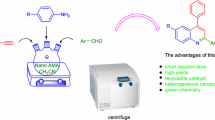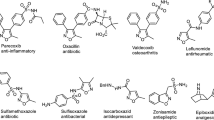Abstract
Mono and disubstituted 2,3-dihydroquinazolin-4(1H)-ones were obtained in good yields via a one-pot, three component reaction of isatoic anhydride and aromatic aldehydes with ammonium acetate or primary amines in the presence of perchlorated zirconia (HClO4/ZrO2) nano particles as an efficient solid acid catalyst under solvent-free conditions. Simple workup and reusability of the catalyst are advantages of this method.
Similar content being viewed by others
References
Kung PP, Casper MD, Cook KL, Wilson-Lingardo L (1999) Structure-activity relationships of novel 2-substituted quinazoline antibacterial agents. J Med Chem 42:4705–4713
Dandia A, Singh R, Sarawgi P (2005) Green chemical multi-component one-pot synthesis of fluorinated 2,3-disubstituted quinazolin-4(3H)-ones under solvent-free conditions and their anti-fungal activity. J Fluorine Chem 126:307–312
Xia Y, Yang Z-Y, Hour M-J, Kuo S-C, Xia P, Bastow KF, Nakanishi Y (2001) Antitumor agents. Part 204:1 synthesis and biological evaluation of substituted 2-aryl quinazolinones. Bioorg Med Chem Lett 11:1193–1196
Jiang JB, Hesson DP, Dusak BD (1990) Synthesis and biological evaluation of 2-styrylquinazolin-4(3H)-ones, a new class of antimitotic anticancer agents which inhibit tubulin polymerization. J Med Chem 33:1721–1728
Abdollahi-Alibeik M, Shabani E (2011) Synthesis of 2,3-dihydroquinazolin-4(1H)-ones catalyzed by zirconium (IV) chloride as a mild and efficient catalyst. Chin Chem Lett 22:1163–1166
Davoodnia A, Allameh S, Fakhari AR, Tavakoli-Hoseini N (2010) Highly efficient solvent-free synthesis of quinazolin-4(3H)-ones and 2,3-dihydroquinazolin-4(1H)-ones using tetrabutylammonium bromide as novel ionic liquid catalyst. Chin Chem Lett 21:550–553
Rostami A, Tavakoli A (2011) Sulfamic acid as a reusable and green catalyst for efficient and simple synthesis of 2-substituted-2,3-dihydroquinazolin-4(1H)-ones in water or methanol. Chin Chem Lett 22:1317–1320
Zhang J, Zhao Y, Luo W, Yu XH, Wang J, Pan Y (2010) Photochemical reaction of magnesium tetraphenyl porphyrin with sulfur dioxide. Chin Chem Lett 21:778–789
Shaabani A, Maleki A, Mofakham H (2008) Click reaction: highly efficient synthesis of 2,3-dihydroquinazolin-4(1H)-ones. Synth Commun: Int J Rapid Commun Synth Org Chem 38:3751– 3759
Shi D, Rong L, Wang J, Zhuang Q, Wang X, Hu H (2003) Synthesis of quinazolin-4(3H)-ones and 1,2-dihydroquinazolin-4(3H)-ones with the aid of a low-valent titanium reagent. Tetrahedron Lett 44:3199–3201
Abdel-Jalil RJ, Voelter W, Saeed M (2004) A novel method for the synthesis of 4(3H)-quinazolinones. Tetrahedron Lett 45:3475–3476
Devassy BM, Halligudi SB (2006) Effect of calcination temperature on the catalytic activity of zirconia-supported heteropoly acids. J Mol Catal A Chem 253:8–15
Tanabe K (1985) Surface and catalytic properties of ZrO2. Mater Chem Phys 13:347–364
Yamaguchi T (1994) Application of ZrO2 as a catalyst and a catalyst support. Catal Today 20:199–217
Bampenrat A, Meeyoo V, Kitiyanan B (2008) Catalytic oxidation of naphthalene over CeO2–ZrO2 mixed oxide catalysts. Catal Commun 9:2349–2352
Liu S, Zhang X, Li J, Zhao N, Wei W, Sun Y (2008) Preparation and application of stabilized mesoporous MgO–ZrO2 solid base. Catal Commun 9:1527–1532
Salavati H, Tangestaninejad S, Moghadam M, Mirkhani V (2011) Zirconia-supported Keggin phosphomolybdovanadate nanocomposite: a heterogeneous and reusable catalyst for alkene epoxidation under thermal and ultrasonic irradiation conditions. C R Chim 14:588–596
Ballivet-Tkatchenko D, dos Santos JHZ, Philippot K (2011) Carbon dioxide conversion to dimethyl carbonate: the effect of silica as support for SnO2 and ZrO2 catalysts. C R Chim 14:780–785
Abdollahi-Alibeik M, Mohammadpoor-Baltork I, Zaghaghi Z (2008) Efficient synthesis of 1,5-benzodiazepines catalyzed by silica supported 12-tungstophosphoric acid. Catal Commun 9:2496–2502
Abdollahi-Alibeik M, Pouriayevali M (2012) Nanosized MCM-41 supported protic ionic liquid as an efficient novel catalytic system for Friedlander synthesis of quinolines. Catal Commun 22:13–18
Mohammadpoor-Baltork I, Abdollahi-Alibeik M (2005) Mild, efficient, and chemoselective dehydrogenation of 2-imidazolines, bis-imidazolines, and N-substituted-2-imidazolines with potassium permanganate supported on montmorillonite K-10. Can J Chem 83:110–114
Abdollahi-Alibeik M, Heidari-Torkabad E (2012) H3PW12O40/MCM-41 nanoparticles as efficient and reusable solid acid catalyst for the synthesis of quinoxalines. C R Chim 15:517–523
Mishra HK, Parida KM (1999) Effect of perchlorate ion on the textural and catalytic activity of zirconia. Appl Catal A Gen 184:219–229
Chen J, Wu D, He F, Liu M, Wu H, Ding J, Su W (2008) Gallium(III) triflate-catalyzed one-pot selective synthesis of 2,3-dihydroquinazolin-4(1H)-ones and quinazolin-4(3H)-ones. Tetrahedron Lett 49:3814–3818
Niknam K, Jafarpour N, Niknam E (2011) Silica-bonded N-propylsulfamic acid as a recyclable catalyst for the synthesis of 2,3-dihydroquinazolin-4(1H)-ones. Chin Chem Lett 22:69–72
Davoodnia A, Allameh S, Fakhari AR (2010) Highly efficient solvent-free synthesis of quinazolin-4(3H)-ones and 2,3-dihydroquinazolin-4(1H)-ones using tetrabutylammonium bromide as novel ionic liquid catalyst. Chin Chem Lett 21:550–553
Rostami A, Tavakoli A (2011) Sulfamic acid as a reusable and green catalyst for efficient and simple synthesis of 2-substituted-2,3-dihydroquinazolin-4(1H)-ones in water or methanol. Chin Chem Lett 22:1317–1320
Zong YX, Zhao Y, Luo WC (2010) Highly efficient synthesis of 2,3-dihydroquinazolin-4(1H)-ones catalyzed by heteropoly acids in water. Chin Chem Lett 21:778–781
Majid G, Kobra A (2011) Eco-friendly and Efficient Synthesis of 2,3-Dihydroquinazolin-4(1H)-ones. Chin J Chem 29:1617– 1623
Subba Reddy BV, Venkateswarlu A (2011) Cellulose-SO3H: an efficient and biodegradable solid acid for the synthesis of quinazolin-4(1H)-ones. Tetrahedron Lett 52:1891–1894
Dabiri M, Mohammadi AA (2009) An efficient and convenient protocol for the synthesis of novel 1′H-spiro[isoindoline-1,2′-quinazoline]-3,4′(3′H)-dione derivatives. Monatsh Chem 140:401–404
Wang B, Li Z, Wang XN (2011) A new approach to the facile synthesis of 2-substituted-quinazolin-4(3H)-ones. Chin Chem Lett 22:951–953
Su W, Yang B (2002) Reductive cyclization of nitro and azide compounds with aldehydes and ketones promoted by metallic samarium and catalytic amount of iodine. AustJ Chem 55:695–697
Shi D, Rong L (2003) Synthesis of quinazolin-4(3H)-ones and 1,2-dihydroquinazolin-4(3H)-ones with the aid of a low-valent titanium reagent. Tetrahedron Lett 44:3199–3201
Acknowledgments
We are thankful to the Yazd University Research Council for partial support of this work.
Author information
Authors and Affiliations
Corresponding author
Rights and permissions
About this article
Cite this article
Hamidi, Z., Abdollahi-Alibeik, M. & Mosavian, S. One-Pot, Three-Component Synthesis of 2,3-Dihydro-4(1H)-Quinazolinones Catalyzed by Perchlorated Zirconia (HClO4/ZrO2) Nanoparticles as a Solid Acid Catalyst. Silicon 10, 2491–2497 (2018). https://doi.org/10.1007/s12633-018-9781-8
Received:
Accepted:
Published:
Issue Date:
DOI: https://doi.org/10.1007/s12633-018-9781-8




